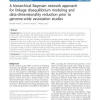Free Online Productivity Tools
i2Speak
i2Symbol
i2OCR
iTex2Img
iWeb2Print
iWeb2Shot
i2Type
iPdf2Split
iPdf2Merge
i2Bopomofo
i2Arabic
i2Style
i2Image
i2PDF
iLatex2Rtf
Sci2ools
BMCBI
2011
2011
A hierarchical Bayesian network approach for linkage disequilibrium modeling and data-dimensionality reduction prior to genome-w
Background: Discovering the genetic basis of common genetic diseases in the human genome represents a public health issue. However, the dimensionality of the genetic data (up to 1 million genetic markers) and its complexity make the statistical analysis a challenging task. Results: We present an accurate modeling of dependences between genetic markers, based on a forest of hierarchical latent class models which is a particular class of probabilistic graphical models. This model offers an adapted framework to deal with the fuzzy nature of linkage disequilibrium blocks. In addition, the data dimensionality can be reduced through the latent variables of the model which synthesize the information borne by genetic markers. In order to tackle the learning of both forest structure and probability distributions, a generic algorithm has been proposed. A first implementation of our algorithm has been shown to be tractable on benchmarks describing 105 variables for 2000 individuals. Conclusions:...
Biometrics | BMCBI 2011 | Common Genetic Diseases | Latent Class Models | Probabilistic Graphical Models |
| Added | 24 Aug 2011 |
| Updated | 24 Aug 2011 |
| Type | Journal |
| Year | 2011 |
| Where | BMCBI |
| Authors | Raphael Mourad, Christine Sinoquet, Philippe Leray |
Comments (0)

